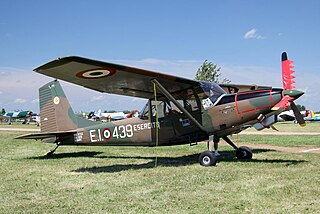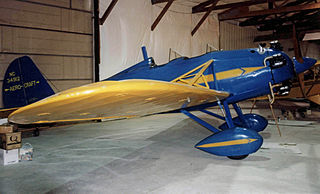Related Research Articles

The Avia BH-5 was a two-seat sport aircraft built in Czechoslovakia in 1923. It was based on the firm's experience with the BH-1 and shared that aircraft's basic design: a low-wing, braced monoplane. It received the nickname "Boska" due to its registration, L-BOSA, an appellation that was later transferred to the various Avia aircraft derived from this design. The BH-5 was flown competitively by Zdeněk Lhota at the Belgian Touring Aircraft Contest in Brussels in 1923, and won both the overall prize for the event and the King of Belgium Prize. The same year, it won the first prize in its class in the Czechoslovak President of the Republic Competition.

The Cessna Model A was a 1920s American high-wing four-seat tourer built by the Cessna Aircraft Company, the first in a long line of high-wing single-engined monoplanes.

The Call-Air Model A is an American two- to three-seat utility aircraft designed by the Call brothers and built by the Call Aircraft Company, later developed into a successful line of agricultural aircraft.

The Fantasy Air Allegro is a Czech two seat, high wing, tricycle gear, single engine monoplane light-sport aircraft or microlight originally designed and built by Fantasy Air and later produced in the United States by Allegro LSA.

The Focke-Wulf A 20 Habicht was an airliner developed in Germany in the late 1920s. It was a high-wing cantilever monoplane with fixed tailskid undercarriage. The fuselage was deep and seated four passengers in a fully enclosed cabin. The type was not bought by the airlines and only a few examples were built.

The SIAI-Marchetti SM.1019 is an Italian STOL liaison monoplane built by SIAI-Marchetti for the Italian Army, and based on the Cessna O-1 Bird Dog.

The JD-2 was a Polish sports plane of 1926. It was the first sports plane designed in Poland, that was built in a small series.
The Partenavia P.55 Tornado is a 1950s Italian high-performance competition and touring monoplane built by Partenavia. The Tornado was a small mid-wing cantilever monoplane with a retractable tricycle landing gear. The aircraft was powered by a nose-mounted Lycoming O-320 piston engine.

The Driggs Dart was an American-built light sporting aircraft of the late 1920s.
The Rans S-16 Shekari is an American single-engined, two-seat, low-wing, aerobatic monoplane designed by Randy Schlitter, built by Rans Inc and sold as a kit for amateur construction.

The X-Air Hanuman is a two-seat, fixed tricycle gear, general aviation ultralight airplane, manufactured in India by Raj Hamsa Ultralights. It is used primarily for flight training, touring, and personal flying. The aircraft is known in North America as the X-Air "H".

The Thaden T-4 Argonaut was a 1930s American four-seat all-metal cabin monoplane built by the Thaden Metal Aircraft Company of San Francisco, California.

The Smith Special also known as "Smitty's Termite" or simply the Smith Termite is a single place homebuilt aircraft built primarily out of wood.

The Travel Air 5000 was an early high-wing monoplane airliner and racing monoplane designed by Clyde Cessna and is chiefly remembered for being the winner of the disastrous Dole Air Race from California to Hawaii.

The Elias EC-1 Aircoupe was an American two-seat parasol wing monoplane designed and built by Elias of Buffalo, New York.

The Aéro Services Guépard Guépard 912 is a French two-seat microlight cabin monoplane designed and built by Aéro Services Guépard to meet the FAI Microlight standard, it is also sold as a kit of parts for amateur construction.

The Aerocraft 2AS is a tandem-seat training aircraft developed from the Kinner Sportwing.

The Vulcan American Moth Monoplane was an early parasol-wing monoplane developed by the Doyle brothers.
The Parmentier Wee Mite was a British two-seat, parasol monoplane designed by Cecil Noel and first flown in Guernsey in 1933.

The Wallace Touroplane was a late 1920s U.S. three seat, high wing cabin monoplane. About 20 were built.
References
- ↑ "Golden Years of Flight Registry". Archived from the original on 19 September 2011. Retrieved 18 October 2011.
- ↑ "Aerofiles" . Retrieved 18 October 2011.
- ↑ "Unknown title". Sport Aviation. November 1960.